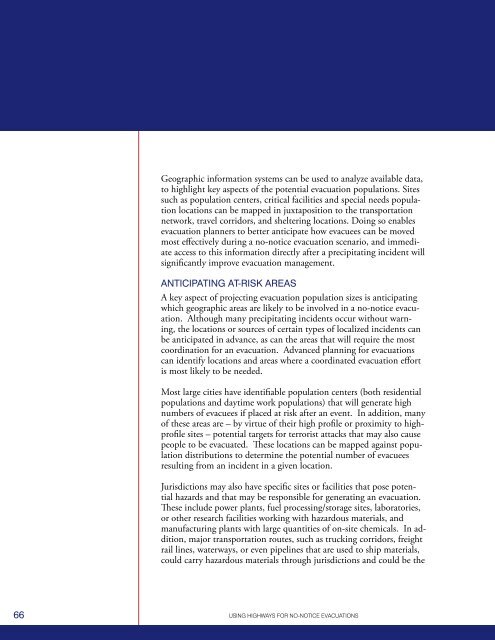using highways for no-notice evacuations - FHWA Operations - U.S. ...
using highways for no-notice evacuations - FHWA Operations - U.S. ...
using highways for no-notice evacuations - FHWA Operations - U.S. ...
You also want an ePaper? Increase the reach of your titles
YUMPU automatically turns print PDFs into web optimized ePapers that Google loves.
Geographic in<strong>for</strong>mation systems can be used to analyze available data,to highlight key aspects of the potential evacuation populations. Sitessuch as population centers, critical facilities and special needs populationlocations can be mapped in juxtaposition to the transportationnetwork, travel corridors, and sheltering locations. Doing so enablesevacuation planners to better anticipate how evacuees can be movedmost effectively during a <strong>no</strong>-<strong>no</strong>tice evacuation scenario, and immediateaccess to this in<strong>for</strong>mation directly after a precipitating incident willsignificantly improve evacuation management.Anticipating at-RIsk AreaSA key aspect of projecting evacuation population sizes is anticipatingwhich geographic areas are likely to be involved in a <strong>no</strong>-<strong>no</strong>tice evacuation.Although many precipitating incidents occur without warning,the locations or sources of certain types of localized incidents canbe anticipated in advance, as can the areas that will require the mostcoordination <strong>for</strong> an evacuation. Advanced planning <strong>for</strong> <strong>evacuations</strong>can identify locations and areas where a coordinated evacuation ef<strong>for</strong>tis most likely to be needed.Most large cities have identifiable population centers (both residentialpopulations and daytime work populations) that will generate highnumbers of evacuees if placed at risk after an event. In addition, manyof these areas are – by virtue of their high profile or proximity to highprofilesites – potential targets <strong>for</strong> terrorist attacks that may also causepeople to be evacuated. These locations can be mapped against populationdistributions to determine the potential number of evacueesresulting from an incident in a given location.Jurisdictions may also have specific sites or facilities that pose potentialhazards and that may be responsible <strong>for</strong> generating an evacuation.These include power plants, fuel processing/storage sites, laboratories,or other research facilities working with hazardous materials, andmanufacturing plants with large quantities of on-site chemicals. In addition,major transportation routes, such as trucking corridors, freightrail lines, waterways, or even pipelines that are used to ship materials,could carry hazardous materials through jurisdictions and could be the66 USING HIGHWAYS FOR NO-NOTICE EVACUATIONS
















